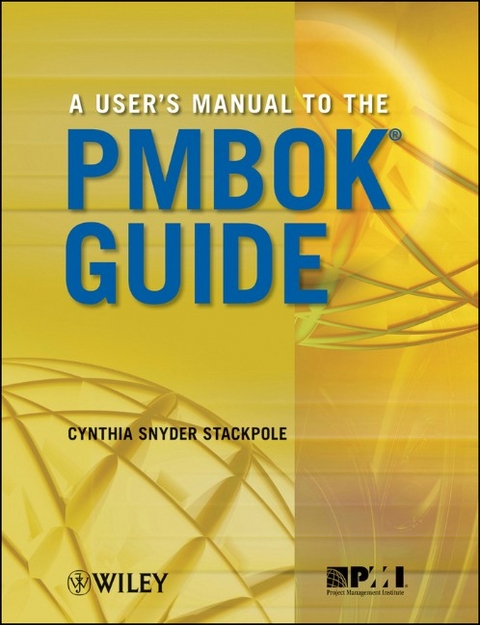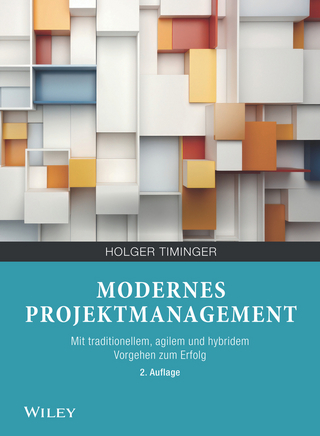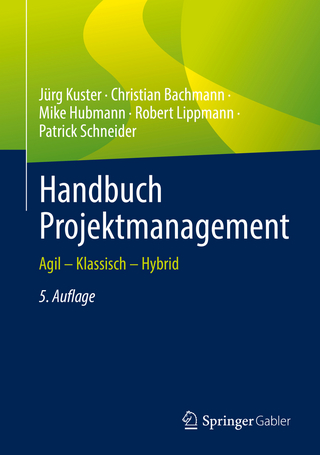
A User's Manual to the PMBOK Guide
John Wiley & Sons Ltd (Verlag)
978-0-470-58489-7 (ISBN)
- Titel erscheint in neuer Auflage
- Artikel merken
The professional standard in the field of project management, A Guide to the Project Management Body of Knowledge better known as the PMBOK(r) Guide published by the Project Management Institute (PMI) serves as the ultimate resource for professionals and as a valuable studying and training device for students taking the PMP(r) exam. A User's Manual to the PMBOK(r) Guide takes the next logical step to act as a true user's manual. Its accessible format and easy-to-understand language helps to not only distill essential information contained in the PMBOK(r) Guide --Fourth Edition, but also fills an educational gap by offering instruction on how to apply its various tools and techniques.
This book: * Defines each project management process in the PMBOK(r) Guide --Fourth Edition, describes their intent, and discusses their individual ITTOs (inputs, tools and techniques, and outputs) * Features examples, handy tips, and sample forms to supplement learning * Is written by the author who was project manager of the PMBOK (r)Guide --Fourth Edition * Contains a data flow diagram of each process in the PMBOK(r) Guide --Fourth Edition to show how information is distributed A User's Manual to the PMBOK(r) Guide simplifies the PMBOK(r) Guide --Fourth Edition to provide the springboard from which successful project management processes are interpreted and carried out in the real world. Thorough in coverage and rich in content, this manual is a worthy companion to augment the important strategies laid out in the PMBOK(r) Guide Fourth Edition--and the one book that aspiring or professional project managers should never be without.
Cynthia Snyder Stackpole is a well-known project management consultant. She was the project manager for the team that created PMI's PMBOK (r) Guide-Fourth Edition . Her successful A Project Manager's Book of Forms has been packaged with the PMBOK (r) Guide-Fourth Edition and is used by professionals and students.
Preface. Acknowledgments. Chapter 1 Introduction. About This Book. Project Management Process Groups. Project Management Knowledge Areas. Chapter 2 Key Concepts. Projects, Programs, and Portfolios. Project Life Cycles. Progressive Elaboration. Tailoring. Project Management Plan and Project Documents. Enterprise Environmental Factors. Organizational Process Assets. Chapter 3 Initiating a Project. Initiating Process Group. Project Sponsor Role. Project Manager Role. Develop Project Charter. Identify Stakeholders. Chapter 4 Planning Scope. Planning Process Group. Planning Loops. Project Scope Management. Collect Requirements. Define Scope. Create WBS. Chapter 5 Planning the Schedule. Project Time Management. Define Activities. Sequence Activities. Estimate Activity Resources. Estimate Activity Durations. Develop Schedule. Chapter 6 Planning Cost. Project Cost Management. Estimate Costs. Determine Budget. Chapter 7 Planning Quality. Project Quality Management. Plan Quality. Chapter 8 Planning Human Resources. Project Human Resource Management. Develop Human Resource Plan. Chapter 9 Planning Communications. Project Communications Management. Plan Communications. Chapter 10 Planning Risk. Project Risk Management. Plan Risk Management. Identify Risks. Perform Qualitative Risk Analysis. Perform Quantitative Risk Analysis. Plan Risk Responses. Chapter 11 Planning Procurement. Project Procurement Management. Plan Procurements. Chapter 12 Planning Integration. Project Integration Management. Develop Project Management Plan. Chapter 13 Executing Quality Management. Executing Process Group. Perform Quality Assurance. Chapter 14 Executing Human Resource Management. Acquire Project Team. Develop Project Team. Manage Project Team. Chapter 15 Executing Communications Management. Distribute Information. Manage Stakeholder Expectations. Chapter 16 Executing Procurement Management. Conduct Procurements. Chapter 17 Executing the Project. Direct and Manage Project Execution. Chapter 18 Monitoring and Controlling Scope. Monitoring and Controlling Process Group. Verify Scope. Control Scope. Chapter 19 Monitoring and Controlling the Schedule. Control Schedule. Chapter 20 Monitoring and Controlling Cost. Control Costs. Chapter 21 Monitoring and Controlling Quality. Perform Quality Control. Chapter 22 Monitoring and Controlling Communications. Report Performance. Chapter 23 Monitoring and Controlling Risk. Monitor and Control Risks. Chapter 24 Monitoring and Controlling Procurement. Administer Procurements. Chapter 25 Monitoring and Controlling the Overall Project. Monitor and Control Project Work. Perform Integrated Change Control. Chapter 26 Closing the Project. Closing Process Group. Close Procurements. Close Project or Phase. Index.
| Erscheint lt. Verlag | 15.10.2010 |
|---|---|
| Zusatzinfo | Illustrations |
| Verlagsort | Chichester |
| Sprache | englisch |
| Maße | 187 x 275 mm |
| Gewicht | 580 g |
| Einbandart | Paperback |
| Themenwelt | Technik ► Elektrotechnik / Energietechnik |
| Technik ► Maschinenbau | |
| Wirtschaft ► Betriebswirtschaft / Management ► Projektmanagement | |
| ISBN-10 | 0-470-58489-0 / 0470584890 |
| ISBN-13 | 978-0-470-58489-7 / 9780470584897 |
| Zustand | Neuware |
| Informationen gemäß Produktsicherheitsverordnung (GPSR) | |
| Haben Sie eine Frage zum Produkt? |
aus dem Bereich



